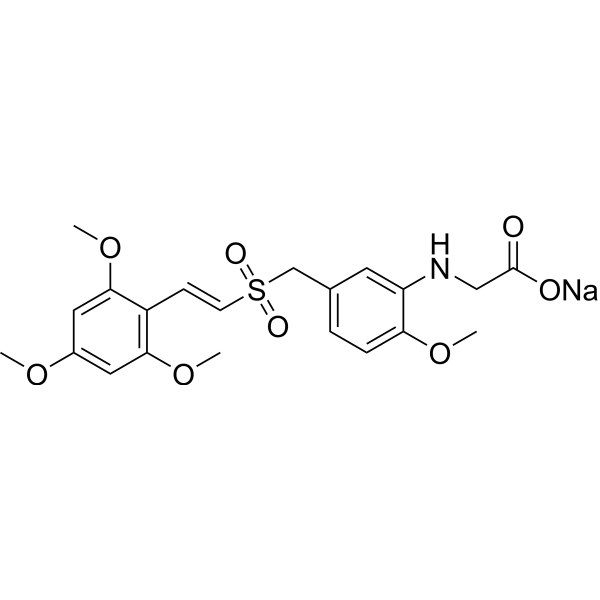| Description: |
Rigosertib (sodium) is a non-ATP-competitive inhibitor of PLK1 with an IC50 of 9 nM, and shows 30-fold selectivity over PLK2. |
| Target: |
PLK1:9 nM (IC50)
PLK2:260 nM (IC50)
PDGFR:18 nM (IC50)
Src:155 nM (IC50)
BCR-ABL:32 nM (IC50)
Cdk1:260 nM (IC50)
Flt1:42 nM (IC50)
Fyn:182 nM (IC50) |
| In Vivo: |
Rigosertib (250 mg/kg, i.p.) markedly inhibits tumor growth in mouse xenograft models of Bel-7402, MCF-7, and MIA-PaCa cells[1]. Rigosertib (200 mg/kg, i.p.) shows inhibition on tumor growth in a mouse xengraft model of BT20 cells[2]. |
| In Vitro: |
Rigosertib is non-ATP-competitive inhibitor of PLK1 with IC50 of 9 nM. Rigosertib also exhibits inhibition of PLK2, PDGFR, Flt1, BCR-ABL, Fyn, Src, and CDK1, with IC50 of 18-260 nM. Rigosertib shows cell killing activity against 94 different tumor cell lines with IC50 of 50-250 nM, including BT27, MCF-7, DU145, PC3, U87, A549, H187, RF1, HCT15, SW480, and KB cells. While in normal cells, such as HFL, PrEC, HMEC, and HUVEC, Rigosertib has little or no effect unless its concentration is greater than 5-10 μM. In HeLa cells, Rigosertib (100-250 nM) induces spindle abnormalities and apoptosis[1]. Rigosertib also inhibits several multidrug resistant tumor cell lines, including MES-SA, MES-SA/DX5a, CEM, and CEM/C2a, with IC50 of 50-100 nM. In DU145 cells, Rigosertib (0.25-5 μM) blocks cell cycle progression in G2/M phase, results in an accumulation of cells containing subG1 content of DNA, and activates apoptotic pathways. In A549 cells, Rigosertib (50 nM-0.5 μM) induces loss of viability and caspase 3/7 activation[2]. Rigosertib sodium (2 μM) induces apoptosis in chronic lymphocytic leukemia (CLL) cells without toxicity against T-cells or normal B-cells. Rigosertib sodium (2 μM) also abrogates the pro-survival effect of follicular dendritic cells on CLL cells and reduces SDF-1-induced migration of leukemic cells[3]. |
| Kinase Assay: |
Recombinant PLK1 (10 ng) is incubated with different concentrations of Rigosertib in a 15 µL reaction mixture (50 mM HEPES, 10 mM MgCl2, 1 mM EDTA, 2 mM Dithiothreitol, 0.01% NP-40 [pH 7.5]) for 30 min at room temperature. Kinase reactions are performed for 20 min at 30°C in a volume of 20 µL (15 µL enzyme + inhibitor, 2 µL 1 mM ATP), 2 µL of γ32P-ATP (40 μCi), and 1 µL of recombinant Cdc25C (100 ng) or casein (1 μg) substrates. Reactions are terminated by boiling for 2 min in 20 µL of 2× Laemmli buffer. Phosphorylated substrates are separated by 18% SDS-PAGE. The gels are dried and exposed to X-ray film for 3-10 min. |
| Cell Assay: |
Cells are grown in either DMEM or RPMI supplemented with 10% fetal bovine serum and 1 unit/mL penicillin-streptomycin solution. Tumor cells are plated into six-well dishes at a density of 1×105 cells/mL/well, and Rigosertib is added 24 hours later at various concentrations. Cell counts are determined from duplicate wells after 96-hour of treatment. The total number of viable cells is determined by trypan blue exclusion. |
| Animal Administration: |
Bel-7402 tumor models: twenty female athymic (NCR-nu/nu) nude mice are injected with 1 × 107 Bel-7402 tumor cells subcutaneously, and 10-14 days later, when the tumor volumes reach 200-250 mm, the mice are divided into four groups such that each group harbors tumors of the same volume. Rigosertib (ON01910, 250 mg/kg) dissolved in PBS is administered alone or in combination with oxaliplatin (100 mg/kg) intraperitonially on alternate days. Tumor measurements are done two times/week using traceable digital vernier calipers. Body weight is determined during each measurement. The animals are observed for signs of toxicity[1]. |
| References: |
[1]. Gumireddy K, et al. ON01910, a non-ATP-competitive small molecule inhibitor of Plk1, is a potent anticancer agent. Cancer Cell. 2005 Mar;7(3):275-86.
[2]. Reddy MV, et al. Discovery of a clinical stage multi-kinase inhibitor sodium (E)-2-{2-methoxy-5-[(2',4',6'-trimethoxystyrylsulfonyl)methyl]phenylamino}acetate (ON 01910.Na): synthesis, structure-activity relationship, and biological activity. J Med Chem.
[3]. Chapman CM, et al. ON 01910.Na is selectively cytotoxic for chronic lymphocytic leukemia cells through a dual mechanism of action involving PI3K/AKT inhibition and induction of oxidative stress. Clin Cancer Res. 2012 Apr 1;18(7):1979-91 |

 DC Chemicals' products qualify for U.S. tariff exemptions. We guarantee no price increases due to customs duties and maintain stable supply, continuing to deliver reliable research solutions to our American clients.
DC Chemicals' products qualify for U.S. tariff exemptions. We guarantee no price increases due to customs duties and maintain stable supply, continuing to deliver reliable research solutions to our American clients.





















